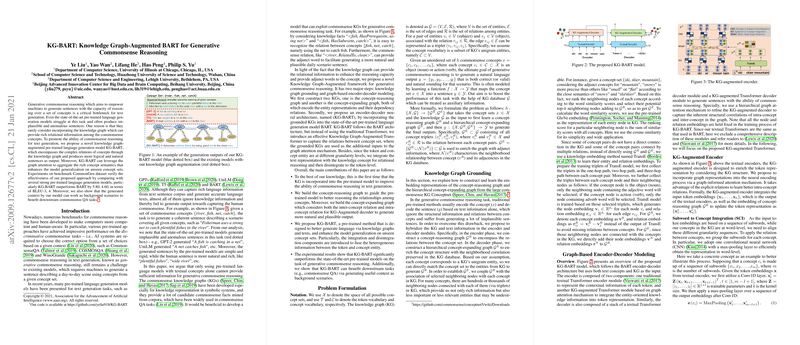Overview of KG-BART: Knowledge Graph-Augmented BART for Generative Commonsense Reasoning
This paper introduces KG-BART, a novel approach that integrates knowledge graphs with pre-trained language generation models, specifically BART, to enhance generative commonsense reasoning. The authors address the challenge that current LLMs often generate sentences that are implausible when tackling tasks requiring commonsense reasoning. Traditional models like GPT and BART depend largely on text corpus and hence lack explicit relational information that knowledge graphs can offer, depicting interrelated commonsense concepts.
Methodology
The core innovation in KG-BART lies in its dual graph-based augmentation process: knowledge graph grounding and graph-based encoder-decoder modeling. These steps leverage knowledge graphs (KGs) to significantly improve the models' capabilities in generating coherent text by enriching the input concepts with relational facts.
- Knowledge Graph Grounding: The proposed method involves creating two grounded KGs — a concept-reasoning graph and a concept-expanding graph. These encode representations of entities and their dependencies derived from established sources like ConceptNet. Importantly, the authors employ TransE for learning embeddings of these graphs, which are crucial for capturing latent relations among concepts.
- Graph-Based Encoder-Decoder Modeling: The KG-augmented approach modifies the BART architecture. The encoder includes a KG-augmented Transformer to assess token-context in conjunction with graph attention to incorporate concept relation semantics. The decoder extends this structure by deploying a hierarchical graph attention mechanism, which balances intra-concept relationships with adjacent node information for richer sentence generation.
Results
Experiments conducted on the CommonGen dataset, designed for generative commonsense reasoning, reveal substantial improvements using KG-BART compared to existing models. For instance, KG-BART shows improvements of 5.80 and 4.60 on BLEU-3 and BLEU-4 scores, respectively, over BART. Such enhancements affirm that KGs can significantly amplify reasoning capacity in text generation by providing adjunct conceptual knowledge via relations in the graph.
Further, comprehensive evaluations including human analysis and transfer to downstream tasks like Commonsense QA verify that adding graph-informed attention mechanisms not only fosters better commonsense text generation but can also enhance broader NLP applications by generating contextual information beneficial in comprehension tasks.
Implications and Future Work
The implications of this work extend into multiple realms of AI. By enhancing LLMs with structured commonsense knowledge, KG-BART opens new possibilities for creating AI systems that can generate more human-like, logical language outputs in storytelling, dialog systems, and beyond. Future developments could explore integrating more extensive KGs and refining attention mechanisms to capture global conceptual relations, potentially addressing common model challenges such as verbosity and repetitiveness.
This paper also sparks conversations on the scalability of such integrations in various domains and encourages the maintenance of fine balances between leveraging vast KGs and managing computational efficiency. Furthermore, adapting this approach to other language generation frameworks like T5 or MASS could yield additional insights and performance gains across diverse language tasks.
